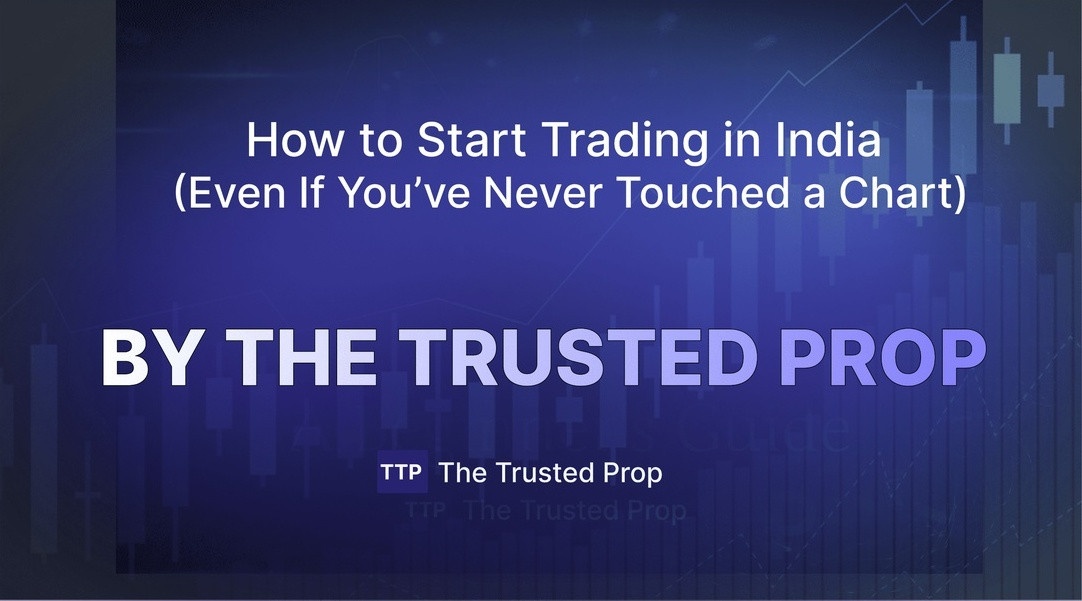Stock Trading in India: Beginner’s Guide to Start with Stock Prop Firms

Stock Trading in India: Beginner’s Guide to Start with Stock Prop Firms
6/19/2025
It usually starts with a question: Can I really make money in the stock market?
If you have ever found yourself scrolling through a finance reel at 1 a.m., wondering if those flashing green charts could one day be yours then you are not alone. From college students trying to outsmart inflation to 9-to-5 professionals chasing financial independence, India’s stock market is quietly becoming one of the most democratic paths to wealth-building. But in reality It’s not easy money, it’s smart money.
This isn’t a hype post. It’s your go-to map for understanding how stock trading in India actually works without confusion, the overwhelm, or the risk of falling into Reddit trap tips.
Let’s decode it all from setting up your first trading account to avoiding emotional trades that tank your savings. And if you're serious about mastering the game, The Trusted Prop has your back with tools, guides, and real insights for smarter trading.
What Is Stock Trading? (And Why Everyone’s Talking About It)

Stock trading is essentially buying a tiny slice of a company like TCS, HDFC, Zomato, you name it with the hope that its value will rise so you can sell it for a profit. These slices, or shares, are bought and sold on India’s two main stock exchanges which is NSE (National Stock Exchange) and BSE (Bombay Stock Exchange).
Two Main Ways to Trade Stocks in India
When it comes to trading stocks in India, there are two popular paths most traders take: intraday trading and delivery trading. Each has its own style, risk level, and time commitment and knowing the difference can shape your entire trading journey.
Intraday Trading
- Buy and sell the same stock within a single day.
- High risk, high speed, high potential reward.
- Not for the faint-hearted or the easily distracted.
Delivery Trading
- Buy shares and hold them for days, months, or years.
- Think of it as building wealth, not just chasing wins.
- Better for beginners, and way less stressful.
Real Talk:
- Most young Indian investors today start with delivery-based trading through apps like Zerodha, Groww, or Upstox.
- Why? It’s simple: they’re easier to use, they demystify the process, and they keep you from making rash moves.
The Backbone of India’s Stock Market: Who’s Behind the Curtain?
Understanding who does what in the market can help you trade smarter and spot red flags early.
| Entity | Role |
|---|---|
| SEBI | India’s stock market watchdog. Regulates and protects investors. |
| NSE & BSE | Platforms where the actual trades happen. |
| Stock Brokers | Your digital gatekeepers (Zerodha, Groww, etc.) |
| Depositories | NSDL & CDSL store your shares electronically. |
| Clearing Corporations | Make sure trades are settled accurately. |
Did you know?
BSE is Asia’s oldest stock exchange (founded in 1875!), while NSE is India’s busiest by trading volume.
How to Start Trading in India (Even If You’ve Never Touched a Chart)

Ready to dip your toes in? Here’s your beginner-friendly breakdown:
1. Pick a Reliable Broker
Look for low fees, a clean user interface, and educational tools.
Top Picks:
- Zerodha: Low fees, trusted by serious traders.
- Groww: Mobile-first, designed for beginners.
- Upstox: Great if you’re into charts and analytics.
- ICICI Direct: Solid option if you want a legacy banking backup.
2. Open a Demat + Trading Account
- Demat Account holds your shares digitally.
- Trading Account is where the buying/selling happens.
Most brokers help you open both in one go digitally, in under 30 minutes.
3. Verify Your KYC + Link Your Bank
- You’ll need your PAN, Aadhaar, bank details, and a signature/photo.
- Verification can take anywhere from a few hours to 2 days.
4. Fund Your Account
- Use UPI, net banking, or IMPS to add money to your trading wallet.
5. Place Your First Trade
- Start with blue-chip stocks like TCS, HDFC Bank, or Infosys.
- They’re stable, well-researched, and less prone to wild swings.
Pro Tip:
Avoid jumping into unknown penny stocks or following random WhatsApp tips. That’s not trading that’s gambling in disguise.
What Kind of Stock Trader Are You? (And Why It Matters)
Not everyone in the market is there for the same reason. Knowing your style can help you avoid strategies that don’t suit your risk tolerance.
Common Trader Types
There’s no one-size-fits-all in trading every trader brings a different mindset, strategy, and goal to the table. From quick scalpers to patient swing traders, understanding the common trader types can help you find your edge in the markets.
| Type | How They Operate |
|---|---|
| Day Trader | Buys and sells within hours. Timing is everything. |
| Swing Trader | Holds for days or weeks to catch trends. |
| Positional Trader | Uses technicals to hold for months. |
| Long-Term Investor | Buys and holds based on company fundamentals. |
Where most newbies fit:
Positional trading and long-term investing tend to be safer, especially if you’re using platforms like Paytm Money or Groww.
Speak the Market’s Language: 5 Terms You Must Know
Trading can feel like learning a foreign language. Start with these:
- Market Order: Buys/sells instantly at current price.
- Limit Order: Executes only when a specific price is hit.
- Stop Loss: Automatically cuts losses at a set threshold.
- 52-Week High/Low: A stock’s peak and dip in the last year.
- Volume: How many shares are being traded momentum indicator.
Bookmark this. Seriously.
The Dark Side of Stock Trading: Mistakes That Cost More Than Money

Let’s be real: the stock market isn’t just green candles and overnight success stories. What most beginners don’t see are the late-night anxiety spirals, the gut-punch losses, and the silent regret of clicking buy without a plan.
This isn’t to scare you but to prepare you. Because once you know where the cracks are, you can walk this path with a lot more confidence and a lot less chaos.
1. The Market Can Flip on You - Fast
A budget announcement. A bad quarterly report. A geopolitical headline you didn’t even see coming. Suddenly, your ‘safe bet’ stock drops 10% in a day and you’re left wondering what just happened.
How to stay sane? Don’t trade the noise. Zoom out. Diversify. Know that short-term pain doesn’t always equal long-term doom.
2. Your Emotions Will Try to Wreck You
Greed when the stock’s pumping. Fear when it’s tanking. Panic when you’re not sure what the chart is even doing anymore.
Sound familiar? Yeah it gets to everyone.
- Anchor yourself, Set rules in advance. Decide your exit before you enter. And when in doubt? Do nothing. The best traders aren’t the smartest, they’re the calmest.
- In trading, 90% of success is emotional discipline. The other 10% is not forgetting the first 90.” - Ramit Sethi, I Will Teach You To Be Rich
3. Overtrading Is the Silent Profit Killer
There’s a rush in clicking buttons. Especially when your app makes it feel like a game. But that “one more trade” mindset? It adds up in fees, taxes, and stress.
Test this for a week: Trade only when your setup is 100% clear. Log it. No FOMO trades. Just clean, intentional moves. You’ll instantly see the difference in results and in your headspace.
4. Leverage Looks Sexy Until It Doesn’t
Your broker says you can borrow funds to ‘maximize gains.’ Sounds tempting, right? But here’s the thing they don’t emphasize: that same leverage can double your losses in seconds.
Ask yourself before using it, If this trade goes against me, can I emotionally and financially handle the hit? If not, you’re not ready. And that’s okay. Most pros don’t touch leverage until years in.
Beginner Stock Trading Strategies That Won’t Blow Up Your Wallet

Forget the high-frequency bots and option-chain chaos. You don’t need a Bloomberg terminal to make your first smart trade. What you do need are strategies that are simple, logical, and built for people with real lives and limited capital.
1. The ‘Buy the Dip’ Approach - When Done Right
Buying when prices drop sounds easy. But here’s the secret: only do it with companies that have strong bones.
Example: If HDFC Bank dips 5% after a weak quarter, that could be an entry point not a red flag.
But if a random micro-cap tanks, stay far away.
This is where basic research trumps guesswork. Always ask: Would I be okay holding this for a year, even if it doesn’t bounce tomorrow?
2. Breakout Trading - Catch the Wave, Don’t Chase It
When a stock moves past a key price level (its “resistance”) with volume, it’s often the start of a strong upward trend.
What beginners miss is they jump in after the move, not as it’s happening. Use alerts. Watch for confirmation. Ride the wave early or don’t ride at all.
3. Moving Averages: Your Lazy-Day Guide to Trends
The 50-day and 200-day moving averages are like footprints in sand. They tell you where the stock has been and where it’s leaning now.
Pro move: When the 50-day crosses above the 200-day? That’s a bullish signal called a ‘golden cross.’ Not foolproof, but worth noting.
4. Practice Without Losing a Rupee
Download Sensibull or TradingView, flip to demo mode, and place fake trades using real-time data.
It sounds boring. It’s actually genius. Paper trading helps you see your patterns without paying tuition in losses.
Stock Market Taxes in India: Don’t Let the Taxman Eat Your Profits

Here’s a scene too many first-time traders know too well:
You sell a few winning trades. You’re feeling great. You brag a little in your group chat. And then… tax season hits and you realize the government wants its cut.
Yeah. No one told you that part. Understanding taxes isn’t just a compliance thing it’s how you keep more of what you earn.
What You Actually Owe (and When)
Let’s break it down like a real-world scenario, not a textbook.
Short-Term Capital Gains (STCG)
- If you sell a stock within 12 months, your profits are taxed at 15% flat.
- Doesn’t matter what tax slab you’re in. 15% it is.
Long-Term Capital Gains (LTCG)
- Hold your stock over a year? You get a break.
- Profits above ₹1 lakh are taxed at 10%.
- So if you earn ₹1.5 lakh profit, only ₹50K is taxed.
Intraday Trading? Whole different game.
- Gains are treated as business income, not capital gains.
- They’re taxed per your income slab and yes, that means higher taxes if you’re earning more.
One Tiny Mistake = Massive Penalty
Say you sell a bunch of stocks in April but forget to log them. Come March next year, your CA asks for records and you’re scrambling through emails and Excel sheets.
Save yourself the headache:
- Download your contract notes regularly.
- Use your broker’s trade history exports.
- Set a monthly calendar reminder. You’ll thank yourself later.
‘You don’t need to be rich to trade smart but you do need to act like someone who’s planning to be.’
- Priya Balasubramanian, SEBI-registered investment advisor
What SEBI Actually Does (And Why You Should Be Glad It Exists)
The stock market isn’t a free-for-all and that’s a good thing. Behind the scenes, SEBI (Securities and Exchange Board of India) is quietly making sure the rules aren’t just suggestions.
SEBI’s Job? Keep the Playing Field Fair
- Cracks down on insider trading (no, you can’t trade based on your cousin’s job at Infosys).
- Makes sure IPOs don’t become pump-and-dump schemes.
- Forces brokers to follow strict transparency rules.
- Introduces rules that help you, the small investor, not just the big sharks.
Recent Rules That Directly Affect You:
- Your trades now settle one day after execution, instead of two.
- Faster access to your money = better cash flow = more trading flexibility.
Tighter Controls on Algo Trading
- Bots and auto-trading platforms are under more scrutiny.
- This helps reduce unfair volatility and gives human traders a better chance.
And yes SEBI updates often. Follow their announcements if you want to stay ahead.
Why this matters:
Trust is everything in the markets. And SEBI’s whole job is making sure that trust doesn’t get trashed.
‘If you’re investing in a system without knowing who regulates it, you’re not investing-you’re hoping.’
- Capitalmind Podcast, Episode 126
Final Thoughts: You Don’t Need to Time the Market—You Just Need to Understand It
Stock trading in India isn’t a game, a shortcut, or a viral hack - it’s a skill. One that’s built slowly, with equal parts knowledge, patience, and humility. If you’ve read this far, you’re already ahead of the curve because most people stop at downloading the app and never truly learn how the system works.
Yes, the stock market can help you build wealth. Yes, even in your 20s or 30s. But only if you treat it with respect, not as a casino, but as a long-term partner in your financial journey.
Stick to the basics. Learn a little every day. Protect your capital like it’s gold. And always trade with your brain, not your gut.
If you're serious about leveling up, check out The Trusted Prop a platform built for modern traders who want tools, knowledge, and trusted guidance to grow smarter.
Because in the end, it’s not just about making money. It’s about keeping it.
You may also like
Top One Trader Detailed Review 2025 (Honest Breakdown)

DNA Funded Funding Types, Fees, Rules & Payouts (2025)

Top One Trader Rules (2025): EAs, News, Copy Trading & More
.jpeg&w=1920&q=75)
ATFunded Trading Rules: Drawdown, News Trading and More
.jpeg&w=1920&q=75)
ATFunded Detailed Review 2025: Challenges, Rules, Payouts & Real Trader Insights

Top One Trader Payout Rules & Profit Split Guide (2025)
.jpeg&w=1920&q=75)
iFunds Account Types, Fees, Rules & Payouts (2025)

No FAQs are available for this topic yet.